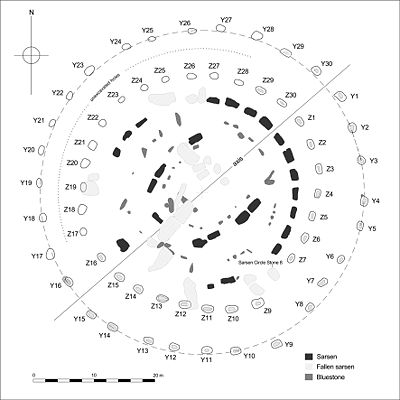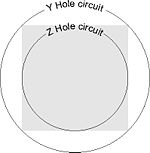
Y and Z Holes
Encyclopedia

Stonehenge
Stonehenge is a prehistoric monument located in the English county of Wiltshire, about west of Amesbury and north of Salisbury. One of the most famous sites in the world, Stonehenge is composed of a circular setting of large standing stones set within earthworks...
. The current view is that both circuits are contemporary. Radiocarbon dating
Radiocarbon dating
Radiocarbon dating is a radiometric dating method that uses the naturally occurring radioisotope carbon-14 to estimate the age of carbon-bearing materials up to about 58,000 to 62,000 years. Raw, i.e. uncalibrated, radiocarbon ages are usually reported in radiocarbon years "Before Present" ,...
of antlers deliberately placed in Y Hole 30 provided a date of around 1600 BC, a slightly earlier date was determined for material retrieved from Z 29. These dates make the Y and Z holes the last known structural activity at Stonehenge. The holes were discovered in 1923 by William Hawley
William Hawley
Lieutenant-Colonel William Hawley was a British archaeologist who most famously undertook pioneering excavations at Stonehenge....
, who, on removing the topsoil over a wide area noted them as clearly visible patches of ‘humus’ against the chalk substrate. Hawley named them the Y and Z because he had earlier, for a short time, labeled the then recently discovered Aubrey Holes
Aubrey holes
The Aubrey holes are a ring of fifty-six Late Cretaceous Seaford Chalk pits at Stonehenge named after the seventeenth-century antiquarian John Aubrey. They date to the earliest phases of Stonehenge in the late fourth and early third millennium BC...
the ‘X’ holes. 18 of the Y Holes have been excavated and 16 of the Z Holes. Further evidence of the Y and Z Holes being late in the sequence of events at Stonehenge is demonstrated by the fact that hole Z 7 was found to cut into the backfill of the construction ramp for stone 7 of the Sarsen Circle.
Description
The outer Y ring consists of 30 holes averaging 1.7m x 1.14m tapering to a flat base typically close to 1m x 0.5m, the inner Z holes, of which only 29 are known (the missing hole may lie beneath the fallen sarsen stone 8), are slightly larger, on average by some 0.1m. They can be best described morphologically as ‘wedge-shaped’. The diameter of the Y circuit, i.e. the best - fit circle is some 54m, that of the Z Hole series, around 39m.The fills of the holes was found to be largely stone free, these deposits are thought to be the result of the gradual accumulation of wind-blown material. Examples of almost every material, both natural and artefactual, that have been found elsewhere at Stonehenge have been retrieved from their fills; this includes pottery of later periods (Iron Age, Romano-British and Medieval) also coins, horseshoe nails, and even human remains.
A new landscape investigation of the Stonehenge site was conducted in April 2009 and a shallow bank, little more than 10 centimetres (4 in) high, was identified between the two hole circles. A further bank lies inside the "Z" circle. These are interpreted as the spread of spoil from the original holes, or more speculatively as hedge banks from vegetation deliberately planted to screen the activities within.
Interpretation
Neither Hawley, nor Richard Atkinson who investigated two of the holes (Y and Z Holes 16) in 1953 thought that uprights of timber or stone had ever been present. Atkinson however suggested that they had been intended to house bluestones, the question remains unresolved. Although unique in many ways a similarity of form between these holes and the contemporary grave pits under the Bronze AgeBronze Age
The Bronze Age is a period characterized by the use of copper and its alloy bronze as the chief hard materials in the manufacture of some implements and weapons. Chronologically, it stands between the Stone Age and Iron Age...
Barrow mounds has been pointed out. Attempts at interpreting the methods of construction used in building the stone monument sometimes show the Y and Z Holes used to locate temporary scaffold–like timber structures or ‘A’ frames. The fact that the stonework has been shown to be around 700 or 800 years earlier than the Y and Z Holes clearly precludes the possibility that the holes represent features cut for constructional purposes. For the same reason the Y and Z Holes cannot be logically introduced into any scheme that suggests they performed a structural function within the design of the stone monument.
Some interpretations introduce the idea that the holes were deliberately laid out in a ‘spiral’ pattern. However their irregular pattern still retains an integrity that can be explained as reciprocal errors created by prehistoric surveyors using a cord (equal to the radius of each circuit) passed around the stone monument
(the presence of the stones would have prevented an accurate circle from being scribed from the geometric centre of the site). The distances between the two circuits appears to have been established by the geometry of simple square and circle relationships (i.e. the Z circuit is contained within a square inscribed within the Y circuit).


